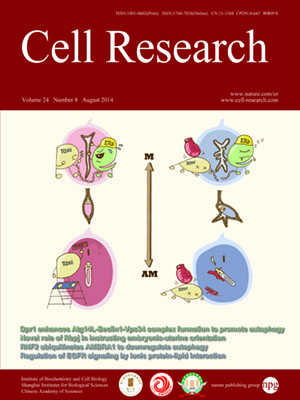
Volume 24, No 8, Aug 2014
ISSN: 1001-0602
EISSN: 1748-7838 2018
impact factor 17.848*
(Clarivate Analytics, 2019)
Volume 24 Issue 8, August 2014: 959-976
ORIGINAL ARTICLES
Regulation of EGFR nanocluster formation by ionic protein-lipid interaction
Ye Wang1,*, Jing Gao2,6,*, Xingdong Guo3,*, Ti Tong4, Xiaoshan Shi3, Lunyi Li3, Miao Qi5, Yajie Wang7, Mingjun Cai2, Junguang Jiang2, Chenqi Xu3, Hongbin Ji1 and Hongda Wang2
1State Key Laboratory of Cell Biology, Institute of Biochemistry and Cell Biology, Shanghai Institutes for Biological Sciences, Chinese Academy of Sciences, 320 Yueyang Road, Shanghai 200031, China
2State Key Laboratory of Electroanalytical Chemistry, Changchun Institute of Applied Chemistry, Chinese Academy of Sciences, Changchun, Jilin 130022, China
3National Center for Protein Science Shanghai, State Key Laboratory of Molecular Biology, Institute of Biochemistry and Cell Biology, Shanghai Institutes for Biological Sciences, Chinese Academy of Sciences, 320 Yueyang Road, Shanghai 200031, China
4Department of Thoracic Surgery, The Second Hospital of Jilin University, Changchun, Jilin 130041, China
5School of Computer Science and Information Technology, Northeast Normal University, Changchun, Jilin 130117, China
6University of Chinese Academy of Sciences, Beijing 100049, China
7Department of Oncology, Changhai Hospital, Second Military Medical University, Shanghai 200433, China
Correspondence: Hongda Wang, E-mail: hdwang@ciac.ac.cn; Hongbin Ji, E-mail: hbji@sibcb.ac.cn; Chenqi Xu,(cqxu@sibcb.ac.cn)
The abnormal activation of epidermal growth factor receptor (EGFR) is strongly associated with a variety of human cancers but the underlying molecular mechanism is not fully understood. By using direct stochastic optical reconstruction microscopy (dSTORM), we find that EGFR proteins form nanoclusters in the cell membrane of both normal lung epithelial cells and lung cancer cells, but the number and size of clusters significantly increase in lung cancer cells. The formation of EGFR clusters is mediated by the ionic interaction between the anionic lipid phosphatidylinositol-4,5-bisphosphate (PIP2) in the plasma membrane and the juxtamembrane (JM) region of EGFR. Disruption of EGFR clustering by PIP2 depletion or JM region mutation impairs EGFR activation and downstream signaling. Furthermore, JM region mutation in constitutively active EGFR mutant attenuates its capability of cell transformation. Collectively, our findings highlight the key roles of anionic phospholipids in EGFR signaling and function, and reveal a novel mechanism to explain the aberrant activation of EGFR in cancers.
10.1038/cr.2014.89
FULL TEXT | PDF
Browse 2435


